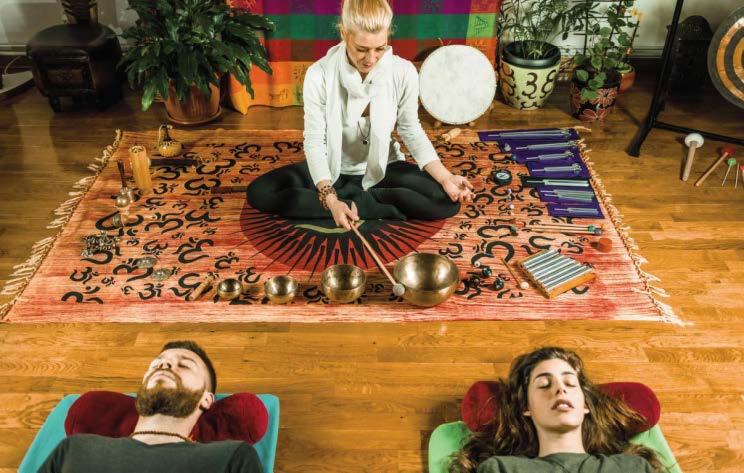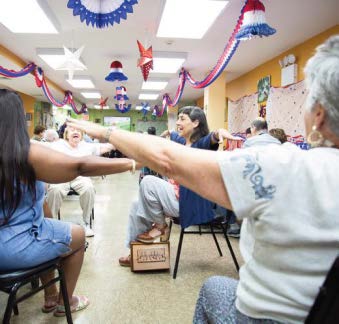Music Therapy & Mindfulness: Brooklyn Music School Launches New Creative Arts Therapy Program

Brooklyn Music School (BMS) announces its new Music Therapy program, offering services for individuals and groups, from ages 5 to 95, beginning in October 2018. Group sessions and classes run in 10-week cycles and take place at 126 St. Felix Street, Brooklyn, NY 11217. Tuition starts at $22 per class and registration is available at http://brooklynmusic- school.org/music-therapy. For Individual Sessions and more information, please call (718) 638-5660.
BMS Music Therapy offers a range of proincluding weekly Sound gramming, Meditation classes in the morning and evening, relaxation and creative expression for seniors, and creative expression through music for all ages. BMS Music Therapy provides option for both individualized and group therapy, so as to meet the specific needs of children and adults in Brooklyn's diverse community. In the therapeutic relationship, the emotional, psycho-social, and developmental needs of our clients are considered and addressed in the process of creating music together through mutual and mindful listening, creative inquiry, and self-expression. Music therapy services are provided by board-certified, licensed music therapists and seasoned sound meditation practitioners under the clinical supervision of Director of Music Therapy Katie Down, (MT-BC, LCAT). All sessions are in compliance with the HIPAA and AMTA Codes of Ethics & Standards.
"Creative arts therapies are now recognized as an essential component to health and wellbeing in hospitals, clinics, and schools. BMS music therapists are trained in the most up-to-date music therapy practices in order to provide a high standard of services," said Katie Down, Director of Music Therapy. "Music has a way of connecting us no matter our age, cultural background, cognitive and physical ability, and these approaches can help to relieve pain and anxiety, enable positive thinking and creativity, and facilitate a profound sense of wellbeing and connection."
"Brooklyn Music School was an innovator in the area of music therapy dating back to World War I, when our faculty employed music as an effective tool to heal returning soldiers whose bodies and souls had been shattered during the Great War," said Crocker Coulson, Chair of the Board of Trustees. "In the intervening decades, music therapy has proven to be efficacious in treating a wide range of issues, from autism and mood disorders in young people to promoting rehabilitation from stroke and remediating Alzheimer's in the aging. We are extremely gratified to reintroduce this important discipline."
For more information about these programs, visit http://brooklynmusicschool.org
SOUND CONCEPTS : BROOKLYN MUSIC SCHOOL MUSIC THERAPY PROGRAMS

Musikids groups of up to 8 for ages 5 to 7 focusing on basic development and cognitive skills, socialization, cooperation, and always a sense of play!
Golden Calm for senior groups, ages 60 and up to help with, focus, memory enhancement, gross and fine motor skills, and social connection through music, gentle yoga stretches, breath-work and guided meditation.
Music and Mindfulness for all ages focusing on contemplative practice in deep listening, relaxation, and connection through music and sound with lessons in the basics of mindfulness with helpful tools to create our own meditation practice with sound and music.
Individual Sessions providing music therapy and music psychotherapy for all ages with a board-certified music therapist and/or LCAT in a dedicated classroom with privacy that can accommodate the needs of each client to be able to express themselves through music. To learn more about music therapy, visit brooklynmusicschool.org
CDC: 1 IN 4 US ADULTS LIVE WITH A DISABILITY
One in 4 U.S. adults – 61 million Americans – have a disability that impacts major life activities, according to a report in CDC's Morbidity and Mortality Weekly Report.
T he most common disability type, mobility, affects 1 in 7 adults. With age, disability becomes more common, affecting about 2 in 5 adults age 65 and older. "At some point in their lives, most people will either have a disability or know someone who has a one," said Coleen Boyle, Ph.D., director of CDC's National Center on Birth Defects and Developmental Disabilities. "Learning more about people with disabilities in the United States can help us better understand and meet their health needs." Using data from the 2016 Behavioral Risk Factor Surveillance System (BRFSS), this is the first CDC report of the percentage of adults across six disability types:
• Mobility (serious difficulty walking or climbing stairs)• Cognition (serious difficulty concentrating, remembering, or making decisions)• Hearing (serious difficulty hearing)• Vision (serious difficulty seeing)• Independent living (difficulty doing errands alone)• Self-care (difficulty dressing or bathing)
These data show that disability is more common among women, non-Hispanic American Indians/Alaska Natives, adults with lower income, and adults living in the South Census region of the United States. The report also shows that:
• After mobility disability, the next most common disability type is cognition, followed by independent living, hearing, vision, and self-care. • The percentage of adults with disability increased as income decreased. In fact, mobility disability is nearly five times as common among middle-aged (45- to 64-year old) adults living below the poverty level compared to those whose income is twice the poverty level.• It is more common for adults 65 years and older with disabilities to have health insurance coverage, a primary doctor, and receive a routine health checkup during the previous 12 months, compared to middle-aged and younger adults with disabilities.• Disability-specific differences in the ability to access health care are common, particularly among adults 18- to 44-years old and middle-aged adults. Generally, adults with vision disability report the least access to health care, while adults with self-care disability report the most access to care.
"People with disabilities will benefit from care coordination and better access to health care and the health services they need, so that they adopt healthy behaviors and have better health," said Georgina Peacock, M.D., M.P.H., Director of CDC's Division of Human Development and Disability. "Research showing how many people have a disability and differences in their access to health care can guide efforts by health care providers and public health practitioners to improve access to care for people with disabilities." CDC is committed to protecting the health and well-being of people with disabilities throughout their lives. Through its State Disability and Health Programs and national collaborations, CDC will continue to work to lower health differences faced by people with disabilities. To advance this goal, CDC provides information and resources for public health practitioners, doctors, and those who care for people with disabilities.
For more information about CDC's work to support inclusive settings for people with disabilities, go to cdc.gov/disabilities •

A FRIEND INDEED: "At some point in their lives, most people will either have a disability or know someone who has a one," said Coleen Boyle, Ph.D., director of CDC's National Center on Birth Defects and Developmental Disabilities.